WWI Destroyers, still active in WW2
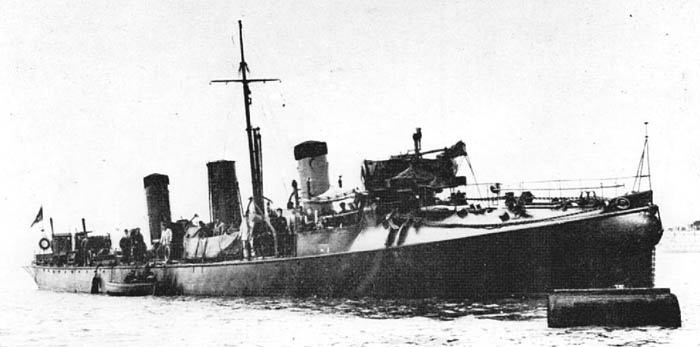
ARA Corrientes
In 1906, Argentina had the following: Three Corrientes class, British-built (Yarrow, Poplar) Havock class 280 tonnes ‘A’ type 1896 vessels, and the torpedo boat Espera (launched 22 April 1890, 520 tons) and eight others. The latter were stricken in 1916-27, while the three Corrientes (Corrientes, Entre Rios, Misiones) were still active in the interwar despite their age: They were only discarded on 23 October 1930. A fourth, ARA Santa Fe, was sunk in Uruguay in 1897 and no longer listed. These were steel-hulled destroyers with turtleback forecastle and three funnels, 26kts/3hrs contracted speed. Thet were reclassified as TBs in the interwar.
In January, 1909 the Argentine parliament was funded enough to start construction of twelve 12 large destroyers under the 1907 program. It was accepted after the 5 years moratorium, by treaty, in reply the Brazilian Navy’s recent acquisitions, which in addition to five destroyers of 1892-98 ordered in 1907 some ten brand-new destroyers (River class) to Britain, the Para class.
Orders for were given after a world’s tender’s request, by the end 1909 to British Cammell Laird. The vessels ordered there were to be named ARA San Luis, Santa Fé, Santiago and Tucumán. The second yard, French A C de Bretagne, obtained the construction of ARA San Juan and Salta and the other French Yard Dyle & Bacalan, Bordeaux, ARA Mendoza and La Rioja. The German Schichau also chosen was to deliver ARA La Plata and Córdoba and Krupp-Germaniawerft ARA Catamarca and Jujuy.
All ships these displacement circa 1,000t, with a specified 32kts top speed. They were all uniformely armed by four 102mm/50 Bethlehem-Vickers guns, and 4 single 21-in (53 cm) torpedo tubes. Given their various yards of origin, they all differed in dimensions, machinery and funnels (or overall appaearance). Thus, Historians made all them separate classes. However only the German-built ships were completed early enough: The remaining 8 destroyers were not commissioned as Contract with Cammell Laird was cancelled by the new Argentine majority, and they were resold to Greece (Aetos class), while the remainder on 9.8.1914 were requisitioned by France, recommissioned as the Aventurier class.
 La Plata class Destroyers (1911)
La Plata class Destroyers (1911)
Córdoba, La Plata

ARA La Plata 1952
German-built destroyer at Schichau, Elbing, Germany, laid down 1910, launched 11.1910 and completed 7.1912: These two German-built destroyers had Curtiss-AEG turbines, Schultz-Thornycroft boilers and mixed firing (coal and oil). On six-hour trials on 18.10.1911, ARA Córdoba reached 34.7kts at 25,000 hp, La Plata 36.8kts at 28,000hp. Both exceeded their contract speed by 2kts, which was a good ad for the yard. In the summer of 1912, they crossed the Atlantic and arrived in Argentina.
Modernizations were made during the interwar, in 1924-1925 their boilers were converted to oil only burn. They carried 220t of oil for a 24,000hp output and 32kts, and a range of 2,700 nm at 15 knots. They carried a single 102mm/50, the same four single 533mm TT but also two four single 37mm/43 (11.2pdr) QF AA Vickers guns were added, and the single tubes were replaced by two twin 533mm TT of a new model, and a Depht Charge Thrower.
Nothing notable happened in their carrer or during WW2. Due to their antiquated powerplant, when the Second World War commenced, these were barely able to reach 27kts. They were stricken only in 10.1.1956, BU in 1959-1960, meaning they saw WWI, WW2 and the cold war as well.
⚙ La Plata class specifications |
|
| Dimensions | 90.0 x 9.00 x 2.80m ( feets) |
| Displacement | 875 tons standard, Displacement 1,368 tons. |
| Crew | 150 |
| Propulsion | 2 Curtis-AEG steam turbines, 5 Schulz-Thornycroft boilers, 28,000 shp |
| Speed | 35 knots ( km/h) |
| Range | Coal 290+oil 50, 2,700-3,000 nm @15 kts. |
| Armament | Four single 102mm/50 Bethlehem No.1 guns, four single 533 mm TT |
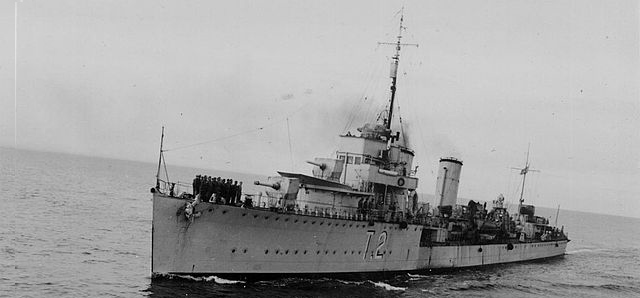
ARA Juan de Garay as T2, 1941
 Catamarca class Destroyers (1912)
Catamarca class Destroyers (1912)
Catamarca, Jujuy
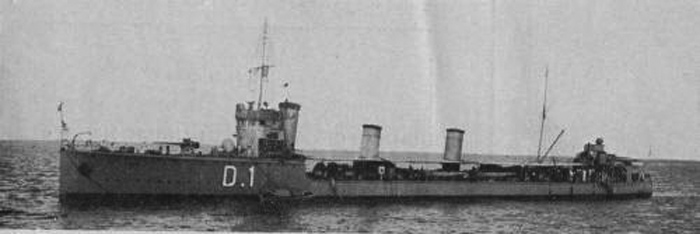
Built in Krupp, these two vessels were launched at different dates: Catamarca in 1911 (date unknown) and Jujuy on 4 March 1912. They were narmed after Andean provinces. They were completed respectively on 13 and 15 April 1912 at a cost of 124,360 £ each, numbered D1 and D2, saling from Germany to Argentina in the summer 1912.
In 1924-1925 both destroyers were modernized: Her boilers were converted to pure oil (they carried 220t of oil for 24,000hp, 32kts, 3000 nautical miles at 15 knots. They receive din addition two single 37mm/43 11.2pdr QF AA Vickers, and two twin 533 mm TT (21 inches) plus a Depht Charge Thrower and acoustic device. During the Second World War beginning they were only capable of 27kts.
⚙ Catamarca class specifications |
|
| Dimensions | 90.0 x 9.00 x 2.80m ( feets) |
| Displacement | 1,522t standard, 2,087t FL |
| Crew | 160 |
| Propulsion | 2 shaft Parsons turbines, 4 Yarrow boilers, 42,000 hp |
| Speed | 36 knots ( km/h) |
| Range | Coal 290+oil 50, 2,700-3,000 nm @15 kts. |
| Armament | 5 x 120 mm, 1 x 76 mm, 4 x 13.2 mm AA HMGs, 6 TT 533 mm (2×3) |
 San Luis class Destroyers (1912)
San Luis class Destroyers (1912)
San luis, Santa Fe, Tucuman, Santiago
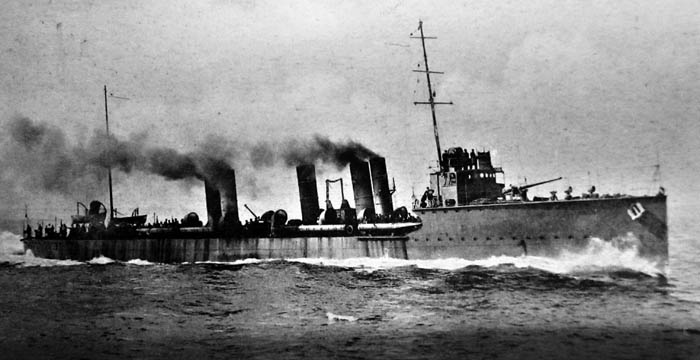
Ierax, ex- ARA San Luis
The 1910 naval plan initiated the construction of 12 TBDs, of which four were to be ordered in UK: This became the San Luis class. The French vessels ordered at the same time had the exact same specs, but diverged in design. They were all smaller, cheaper destroyers compared to the previous Catamarca/La Plata, lighter, and with almost half the power output, smaller guns.
The British vessels were ordered to Cammel laird, but like the French vessels they were ordered with the same American Curtis turbines and Forster boilers. They were caracterizes by five funnels, two in tandem pairs, giving them a very unique profile. They carried 250 rounds per guns and were narmed after towns. Construction was suspendeded, the four vessels were requisitioned
Launched in February, March, April and July 1911 at Birkenhead, they were purchased in 1912 by Greece, ready for delivery at £148,000 apiece when the Balkan Wars seemed likely, due to the payment defaut and cancellation from Argentina. They sailed with non-Greek crew to Algiers, meeting Ionia with the Greek crews and started a ling career between the 1911 war, WWI and WW2.
⚙ San Luis class specifications |
|
| Dimensions | 89.2 x 8.4 x 3m (292 x 27 x 9 feets) |
| Displacement | 980t standard, 1,175t FL |
| Crew | 110 |
| Propulsion | 2 shaft Curtis turbines, 4 White Forster boilers, 20,000 shp |
| Speed | 32 knots ( km/h) |
| Range | Coal 225+oil 75, 3,000 nm @15 kts. |
| Armament | 4 x 102 mm, 4x TT 533 mm (2×2) |
 Mendoza class Destroyers (1912)
Mendoza class Destroyers (1912)
Mendoza, Salta, San Juan, Rioja

Author’s rendition of the Mendoza class/Aventurier
The 1910 plan initiated the construction of 12 TBDs, four to be built in France at Ch. de Bretagne, Nantes in 1910. The French boats had three funnels and their magazine capacity was 250 rounds for each gun. Still in construction by August 1914 (it was suspended since the new political changes in Argentina), launched in 18/02/1911, 25/09/1911, 18/02/1911 and 1911 respectively, suspended, they were immediately taken over by the French Government due to the mobilization.
They were completed to the French standards and given the Aventurier class name: Aventurier, Intrepide, Opiniatre, Temeraire entered service later in 1915 and served in WWI and the interwar. Four boats were ordered by Argentina to replace them, never delivered due to the war.
⚙ Mendoza class specifications |
|
| Dimensions | 90.0 x 9.00 x 2.80m ( feets) |
| Displacement | 940t standard, 1,170t FL |
| Crew | 110 |
| Propulsion | 2 shaft Curtis turbines, 5 White Forster boilers, 19,500 hp |
| Speed | 32 knots ( km/h) |
| Range | Coal 246+oil 82, 3,000 nm @15 kts. |
| Armament | 4 x 102 mm/50, 2×2 TT 533 mm |
Interwar Argentinian Destroyers
In 1924, as relations with Brazil deteriorated, a limited naval plan was adopted given the capacity of Argentinian shipyards, still unable to build destroyers. This plan included modernization of the two US-built Rivadvia class battleships, and in 1926, while 75 million pesos were granted for a 10-year plan. This included the acquisition of destroyers in 1925, two to Spain, the Churrucca class (British 1918 flotilla leader model), so hopefully compatible with British ordnance and cheaper that British vessels. Next in in 1928, four directly to Great Britain and in 1936, seven off the “G” type, by far the most extension ambitious plan.
 Cervantes (Churucca) class Destroyers (1925)
Cervantes (Churucca) class Destroyers (1925)
Cervantes, Juan de Garay
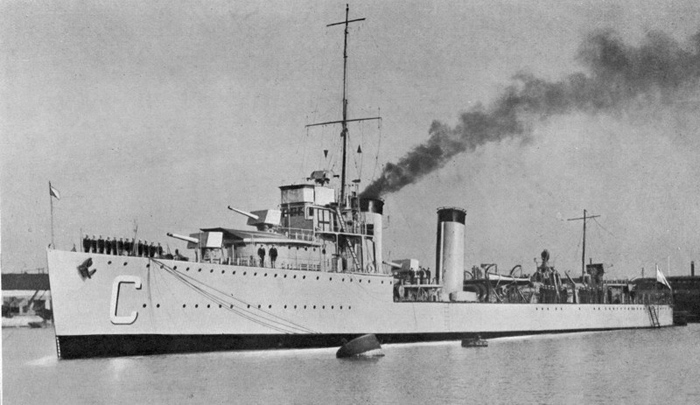
ARA Cervantes
On the occasion of the flight of the Dornier Wal “Plus Ultra” to Buenos Aires, the Spanish government sent Méndez Núñez and the destroyer Alsedo on a goodwill visit to Buenos Aires, La Plata on February 7, 1926. This visit coincided with the promulgation of plans to modernize the material of the Argentine Armed Forces. The Alsedo in particular aroused so much interest in the Navy of the Argentine Republic (ARA) that it immediately dispatched a commission to the peninsula to begin negotiations for the construction of a flotilla of similar units.
By Royal Decree of May 25, 1927, the Spanish government granted a loan of 100 million pesetas to Argentina. The ARA, for its part, ruled out the Alsedo, opting for the new Churruca-class units. Therefore, the Churruca and the Alcalá Galiano were sold to the ARA, where they would be baptized ARA Cervantes and ARA Juan de Garay.
Originally for its new naval program, Argentina wanted to order two vessels to Spain, as the admiralty was already interested in the new HMS Scott class flotilla leaders from Great Britain, unveiled in 1916 and a far superior design at the time. Spain started a series inspired by the latter, the Churruca class.
Two of them, Cervantes and Juan de Garray, were purchased while under construction based on cost concerns, with this Spanish loan. The ships were Churruca (Cadiz), launched 26 June 1925, sold 10 June 1926 and completed 3 September 1927, renamed ARA Cervantes and Alcalá Galiano La Carraca, Cartagena on 2 November 1925, comm. the same day. They both entered into service as ARA Cervantes (E1) and ARA Juan de Garay (E2).
Capable of 36 knots, which was a game changer for Argentinian destroyers (barely able of 28 kts), they were also heavily armed with their triple torpedo tubes banks, depht-charge throwers (and sonar), and heavy artillery. They even incuded a substantial AA for long and short range, plus state of the art rangefinders for and aft. Cervantes reached 39.76 knots (73.64 km/h; 45.75 mph) on sea trials.

ARA Juan de Garay as T2 in 1941
She was purchased from Spain for the amount of 1,750,000 gold pesos and arrived in Buenos Aires, from Cádiz on January 10, 1928. In 1929 both were assigned to a newly formed squadron, First Naval Region based in Puerto Belgrano.
In 1941 both were reclassified as torpedo boats. Their service was spotless, including during WW2, patrolling Argentinian waters. They were modernised after World War II.
After the war from 1950 they served in Río Santiago naval base, assigned to the Naval Instruction Force, Naval Military School, training cadets for the more modern 1929 and 1927 vessels.
In 1952, the two were reclassified as destroyer escorts (torpederos) and ARA Cervantes was severely damaged by an attack of Argentinian Gloster Meteor loyal to Juan Domingo Perón while evacuating personnel from the rebel naval base of Río Santiago (Revolución Libertadora). ARA Cervantes was forced to take refuge in the Uruguayan port of Montevideo until the rebels were victorious, and returned to Argentina. She was placed in reserve in May 1961, stricken in june, while Juan de Garay became training vessel from 1952 and until 1959, stricken 25 March 1960.

⚙ Mendoza class specifications |
|
| Dimensions | 90.0 x 9.00 x 2.80m ( feets) |
| Displacement | 1,560 tons standard, 2,205 t full load |
| Crew | 175 |
| Propulsion | 2 shaft Parsons turbines, 4 Yarrow boilers, 42,000 hp (31,000 KW) |
| Speed | 36 knots (67 km/h) |
| Range | 4,500 nmi (8,300 km) at 14 knots (26 km/h). |
| Armament | 5 x 120/45 mm, 1×76 mm, 4×13.2 mm AA HMGs, 2×3 TT 533 mm, 2 DCT |
 Mendoza class Destroyers (1928)
Mendoza class Destroyers (1928)
ARA Mendoza, Tucumán, La Rioja
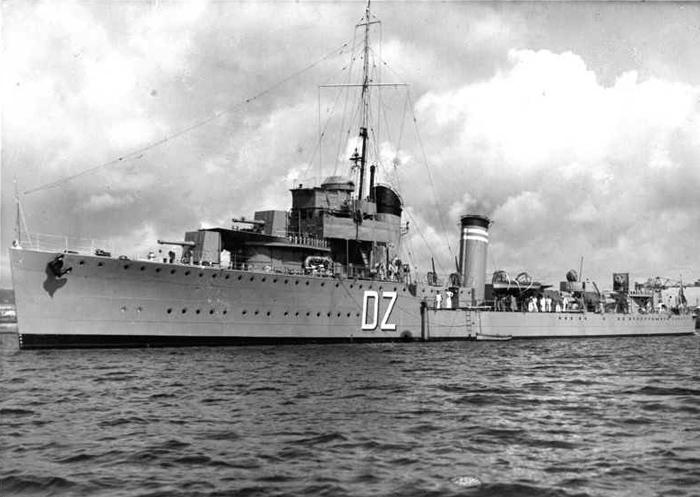
ARA Jose Luis Diez
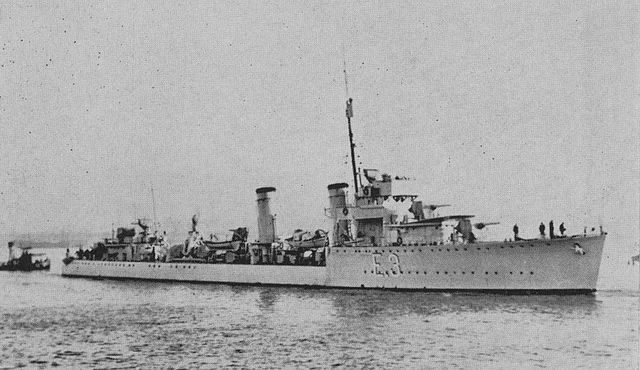
ARA Mendoza in 1932
These three vessels were the first part of the Argentine re-armament programme of 1926, ordered J. Samuel White & Co, Cowes, taking the names of vessels under construction during WWI, appropriated by France and Germany. They were launched 18 July 1928, 2 February 1929 and 16 October 1928 respectively, and commissioned in January to July 1929. These were essentially designed based on the British Admiralty type flotilla leader of 1918, with few alterations. Standard displacement was 1,595 tonnes (1,570 long tons) for 2,154 tonnes (2,120 long tons) fully loaded, 102.11 metres (335 ft) overall in lenght for 101.2 metres (332 ft) at the waterline and a 9.68 metres (31 ft 9 in) beam, 3.81 m (12 ft 6 in) mean draught.
As for the powerplant, they relied on Parsons single-reduction geared turbines, fed by four 250 psi (1,724 kPa) three-drum Admiralty boilers. 42,000 shaft horsepower (31,319 kW) was the rated output passed into the two propeller shafts. Designed speed was 36 knots (67 km/h; 41 mph), which they outperformed on trials (La Rioja for example reached 39.4 knots (73.0 km/h; 45.3 mph) without overheating her boilers). And for range they carried carried 549 tonnes (540 long tons) of fuel oil in normal load, for a range of 4,500 nautical miles (8,300 km; 5,200 mi) at 14 knots, and a complement of 160 officers and ratings.
As for armament, they counted like the previous vessels, five 4.7-inch (119 mm) QF Mark IX guns in single shielded mounts along the centreline. A 3-inch (76 mm) AA gun was mandatory, in between funnels, as well as two 2-pounder pom poms AA guns for closer range. The six 21-inch (533 mm) torpedo tubes were placed in two triple mounts aft. This will change during their career.
When completed they sailed for Argentina from the United Kingdom, stopping at Lisbon, underway to cross the gap. Argentina remained neutral during the war so their service was rather uneventful.
In 1952, these “Exploradores” (destroyers) were redesignated as “Torpederos” (destroyer escorts) with pennant numbers swapping “E” to “T”. All three destroyers were converted to anti-aircraft escorts in 1958, with 3-inch and two 2-pounder replaced by ten 40 mm Bofors guns. La Rioja and Tucuman were laid the same year, disarmed and converted to ASW escorts. ARA Mendoza remained in service until 1961, decommissioned, discarded on 30 April 1962. They were replaced by modernized USN Fletcher class vessels.

⚙ Mendoza class specifications |
|
| Dimensions | 102.11 x 9.68 x 3.81m (335 x 31 x 12 feets) |
| Displacement | 1,595t, 2,154t FL |
| Crew | 160 |
| Propulsion | 2 shaft Parsons turbines, 4 Yarrow boilers, 42,000 hp |
| Speed | 36 knots (67 km/h, 41 mph) |
| Range | 4,500 nm (8,300 km; 5,200 mi) at 14 knots |
| Armament | 5x 4.7 in, 1x 3-in + 2x 2-pdr pompom AA, 2×3 21-in TT |
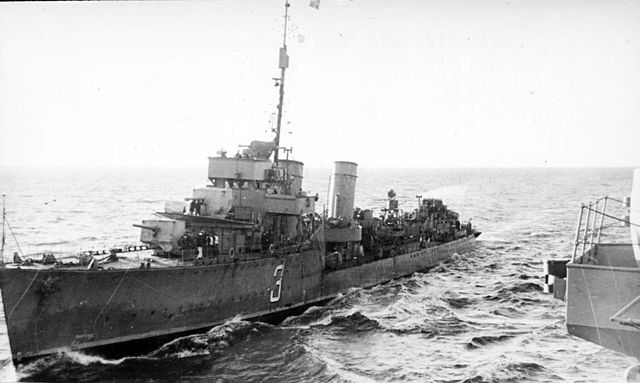
ARA Mendoza in the 1950s
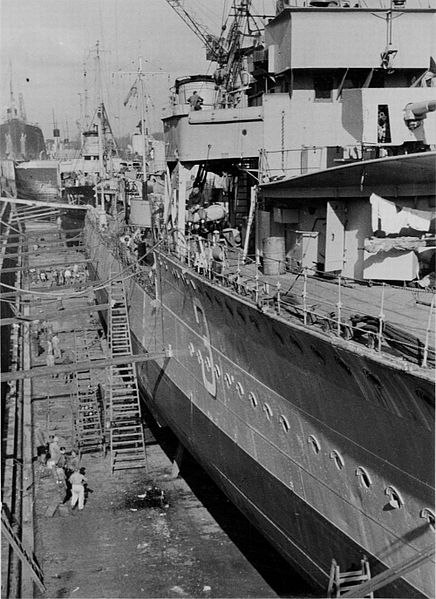
Mendoza in Tandanor, 1959
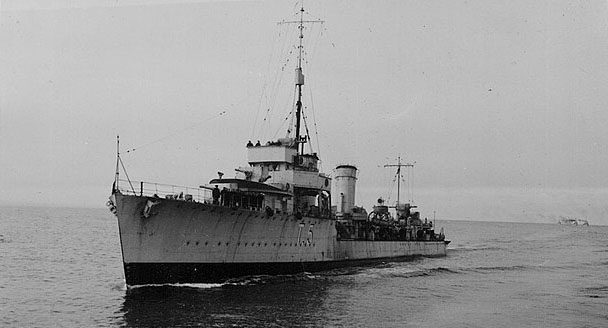
ARA Tucuman in 1940
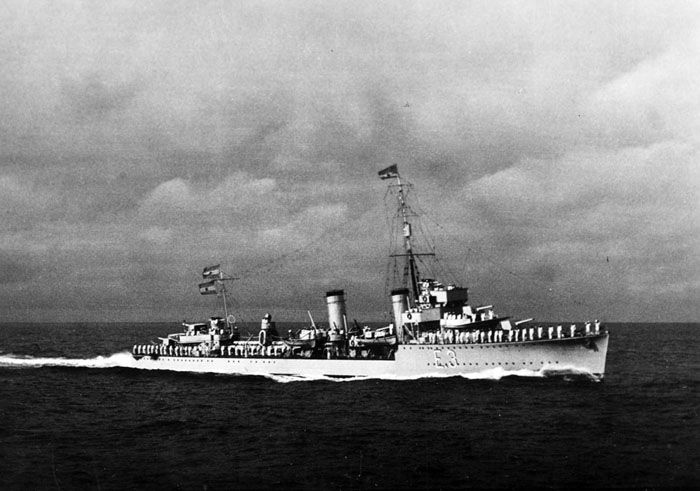
Mendoza on speed trials

La Rioja between 1929 and 1931
 Buenos Aires class Destroyers (1937)
Buenos Aires class Destroyers (1937)
ARA Buenos Aires, Corrientes, Entre Rios, Misiones, San Juan, San Luis, Santa Cruz
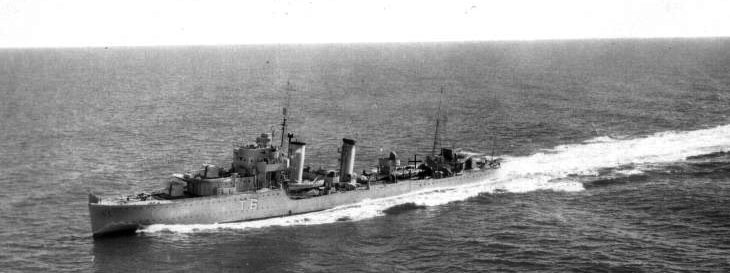
ARA Buenos Aires
The same naval plan that saw the Cruiser La Argentina being ordered was assorted with seven destroyers, to be purchased in England. They basically “G” class vessels as delivered to the British Royal Navy, with a few modifications to suit Argentine requirements. A bit small than previous Mendoza class, at 1,375 t (1,353 long tons) standard and 2,042 t (2,010 long tons) full load, shorted at 98.45 m, they were broader at 10.38 m as were late 1930s standard destroyers: The Mendoza and preceding vessels were based on late WWI destroyer leaders.
This was also reflected in their weaponry, with four main guns instead of five, but of the new, much faster and longer range QF Mark IX. The Argentines for AA chose the italian Breda 12.7 mm heavy machune guns instead of the standard 3-in or 2-pdr pompom fr AA defence. Torpedoe armament was upgraded, both with quadruple tubes and a new model of 21-in torpedo. Their rangefinders were also brand new and far more accurate, longer range than those of the 1920s generation.
Power-wise, they adopted the classic two shafts, two geared Parsons steam turbines fed by three admiralty boilers, for a total of 25,000 kW (34,000 hp). Not impressive compared to the Mendoza class, this made for a top speed of “only” 35 knots (65 km/h; 40 mph) – Which they all exceeded in trials anyway – a knot traded for a 4,100 nmi (7,600 km) range at 14 kn (26 km/h; 16 mph).
After World War II, two single hand-worked 40 mm (1.6 in) Bofors were installed in addition between funnels plus two twin air-cooled Bofors of Swedish Mark, only used by the Swedish navy instead of the more common allied model. It was located where was the aft bank of torpedo tubes. Radar and sonar were fitted also. ARA Santa Cruz had her “B” gun exchanged for a Hedgehog ASWRL to increase her capabilities.
ARA Corrientes collided with ARA Almirante Brown (cruiser) in dense fog during naval exercises. She was rammed and nearly cut in two, sinking rapidly on 3 October 1941, 54 nm NE of Mar del Plata. On 19 September 1955 (Revolucion Libertadora), the destroyers ARA San Luis, San Juan and Entre Rios escorted the cruiser ARA Nueve de Julio shelling fuel depots in Mar del Plata, the destroyers also shelling armed civilians and soldiers trying to invade the naval base, also later shelling the loyalist headquarters of the AA School north of the city.
They were among the world’s oldest British-built interwar destroyers ever discarded, in the 1970s when replpaced by missile-armed US FRAM II destroyers.
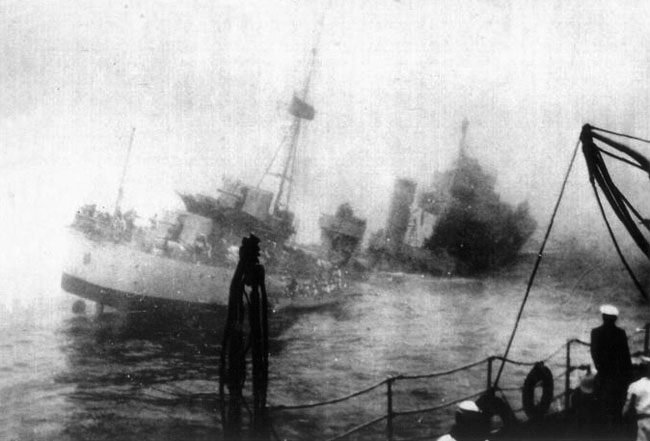
Sinking_ARA_Corrientes
⚙ Mendoza class specifications |
|
| Dimensions | 98.45 x 10.58 x 5 m ( feets) |
| Displacement | 1375t, 2300t FL |
| Crew | 130 |
| Propulsion | 2 shafts Parsons turbines, 4 Yarrow boilers, 42,000 hp |
| Speed | 35.5 knots ( km/h) |
| Range | Coal 246+oil 82, 3,000 nm @15 kts. |
| Armament | 4 x 120, 8 x 40 mm Bofors AA, 8 TT 533mm (2×4). |
Ship’s logs: ARA La Rioja
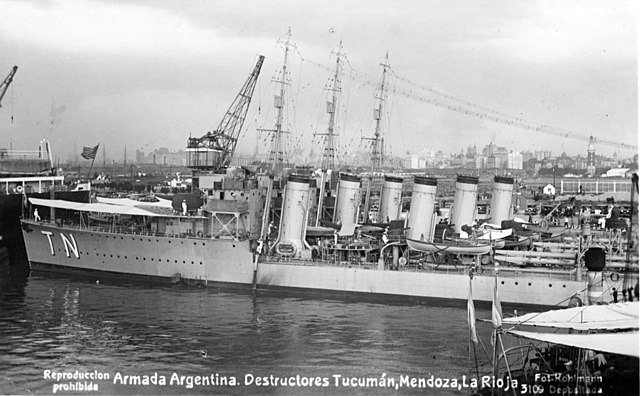
Tucuman, Medoza and La Rioja in 1933
This is an example typical service record history for these destroyers. Full logs can be found on histarmar.com.ar (link at the end).
La Rioja is launched on January 26, 1929 and by September 21, 1929 she is delivered as completed, with the national flag hoisted in a ceremony. She made a short trip to the Netherlands where her fire control system is installed, and returned to the shipyard for titting out work in October 1929, setting sail for the Argentinian Republic, in division with her sister ships ARA Mendoza and ARA Tucumán.
In November 1929, she arrives at the Puerto Belgrano Naval Base. She hosted Comodoro Rivadavia, the Army Inspector General on board for a short cruise, returning to Puerto Belgrano in December and move to Buenos Aires at the end of the year. First commander was Frigate Captain D. Francisco Dairieu. In February 1930, Frigate Captain D. Félix Mac Carthy took command and she remained under the main fleet command. Exercises wient on from B. N. P. B. (Puerto Belgrano Naval Base) as naval station.
Frigate Captain D. Osvaldo Repetto taked command and she is part of the ‘Exploration’ Squadron of the 51 Division stationed at Puerto Belgrano Naval Base. By 1931 command is assumed in turn by the Frigate Captain D. Vicente Ferrer. She carrie out a mission to Ushuaia, related to control and surveillance of the area, were were located numerous political prisoners. By O.G. 93/31 directive she is reclassified as “Explorer” (destroyer) simply and enters her first large overhaul about May-June at the Naval Base Yard Puerto Belgrano. In November 1930 Frigate Captain D. Secundino Odriozola takes command.
In 1932, command fell on Frigate Captain D. Juan Chihigaren and she remained in the 1st destroyer squadron, main battle squadron at Puerto Belgrano Naval Base, alsway training in Atlantic waters. In 1933 Captain D. Carlos M. Sciurano takes command and the destroyer participates in normal training sweeps until the end of the year. By September she escorts the battleship ARA Moreno to Brazil for a goodwill cruise and returning in mid-October at Puerto Belgrano Naval Base and by In August 1933 she visits Montevideo.
In 1934 Frigate Captain D. José Zuloaga takes command and she stopped in Buenos Aires to participate in a national festival. In 1935 under command of Captain D. Juan Asconape she carries out several training with the Fleet and 1936
(Captain Asconape) this routine went on. By December, D. Ricardo López Campos takes command, and training resumed, interrupted with an escort mission of the US Naval Division carrying President Roosevelt in a state visit to Argentina.
By 1937 Captain López Campos takes command, and she she made a long training cruise through the South Atlantic and Pacific for the first time, reaching Callao. When done, she returns to Puerto Belgrano and training routine. In 1938
she had a new Commander, Captain D. Harald Cappus, and resumes yearly fleet training. In 1939 Frigate Captain D. Guillermo Montenegro taked command in March, until December, followed by by Captain Montenegro in 1940 and Frigate Captain D. Gabriel Maleville. This time, like her sister, she is transferred to the 2nd Flotilla stationed at Puerto Belgrano.
In 1941 by directive O.G. 95/41 she is reclassified as Torpedero or “Escort Destroyer”, Commanded by Frigate Captain D. Leandro Elizondo, 1st Division Escort DDs Squadron, main battle fleet. In 1942 Captain Elizondo stays in command and on May 25, she sails to Ushuaia to join the national holidays celebration there. In July 1942, she attends Independence festivities in Buenos Aires. In 1943 Fragata D. Jos? Schwarz who in July hands it over to the Frigate Captain D. Ernesto Villanueva takes command, and she participates in normal activities and training that year.
By March 1944, Captain D. Salvador Garat taks command, followed in December that year by Captain D. Juan C. Cairo and in December 1945 by Commander Julio Petrocchi. In 1946 she moved to Chile to join the celebration of the transmission of presidential powers and spent the rest if the year operating in the Atlantic from Puerto Belgrano.
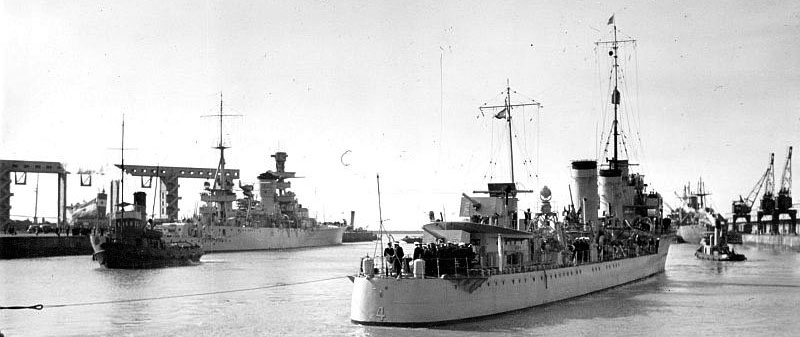
ARA La Rioja close to the cruiser Nueve de Julio in Puerto Belgrano (Archivos de la Nacion)
In 1947 Frigate Captain D. Julio Casanova taks command and routine exercises in the South Atlantic follows. In 1948 Captain D Silvano Harriague taks command and she becomes flagship or the 2nd Squadron of escort DDs where she is reassigned. On May 25, she tooks part in the national holidays, and on July 9, she is present in Buenos Aires. In September Lieutenant Commander D. Emilio L. Díaz accidentally took charge of command during a violent storm seeing Harriage injured in September.
In 1949 Captain of the Ship D. Rodolfo Chierasco taks command, as commander of the 2nd Escort DDs, still as flagship. By the end of January Commander D. Ricardo Hermelo taks command in turn, then Captain D. Adolfo B. Estévez. 1950
starts with the appointment of Corvette Captain D. Carlos A. Sosa and she is rassigned to the 1st escort DD of the Fleet. In April, Corvette Captain D. Mario S. T. Lanzarini took command but the agieng ship sees little naval activity. In 1951 Cap. Frigate D. Adolfo Videla and in May Captain D. Pedro P. Rivero are in command and La Rioja saw at least two training sorties in South Atlantic waters.
In 1952 she is reassigned to the 3rd torpedero Division, with few sorties if any. Decommission, disarmament and major overhauled are carried out at Puerto Belgrano Yard. Until june 1953 she is drydocked, while Frigate Captain Enrique Plater taked command at recommission. La Rioja is assigned to the Naval Training Force at Perto Belgrano ans appointed to the academy to train Cadets. She visits Buenos Aires in July 1953. The next year, Frigate Captain D. Raúl Angelini Farach takes command and she resumed her cadet training, participating in a major fleet exercises in del Plata waters.
In 1955 Frigate Captain Rafael Palomeque Barros takes command and she resumes her training duties until the “Liberating Revolution” taks place: From September 16, she evacuates cadets of the Military Naval School of Río Santiago and while underway in the Río de la Plata, she is attacked by loyalist planes, straddled, with one killed, the 29-year-old Cadet D. Edgardo L. Guillochon due to the air blast. The air attacks are however repelled by AA fire and the destroyer reaches Buenos Aires on September 26 with other units incorporated on the 19, after delivering their wounded to the Uruguayan tugboat “Capella y Pons”.

La Rioja during the “Revolucion Libertadora”, after the air attak, showing her hull partially burnt.
In 1956 command fell to Frigate Captain Carlos X. Coda and remains attached to cadet training from Puerto Belgrano often training in La Plata. In 1957 she is always part of the Naval Training Force, with Cadets in the same waters and in 1958 Captain Mariano A. Fernández takes command. She is reassigned and converted as a “fast anti-submarine frigate”, disarmed and decommission under supervision of Lieutenant Commander D. José A. Lagomarsino. In 1959
Corvette Captain D. Alberto J. Pantín is appointed and Julio A. Vázquez, while conversion took place as for ARA Tucumán. Machinery is overhauled while in drydock, general installations modenrized and new Bofors anti-submarine rocket launcher equipment are fitted while firing stations, Signal apparatus and sonars plus a Phillips search radar are fitted. All the electrical wiring and generators are also upgraded.
In 1960 Captain Carlos A. Pujol takes charge while the conversion went on, apparently dragging on due to budgetary issues and shortages. In 1961 the conversion has been postponed, and virtually suspended. In 1962 by decree No.3843 of April 30, 1962 she is discared, stricken and put on sale. A public auction takes place in December, and on January 14, 1963 she is sold for 2,365,000 psts to “Rochametal S. R. L.” for BU. La Rioja was the first Argentinian Navy ship named in homage to the Argentine province.
WW2 and post-war evolution

ARA Azopardo (P35): Studied from 1940 in AFNE Rio Santiago, she was only completed in 1956, their role being shifted to ASW Frigates and design reworked entirely. Due to shortages, they real laying down was redone in 1950.
Apart Frigates built in Argentina, the King class (completed in 1945) mostly intended for ASW patols, or the Bouchard class minesweepers, Argentina did not have the means to built larger vessels and could not obtain some from any belligerent.
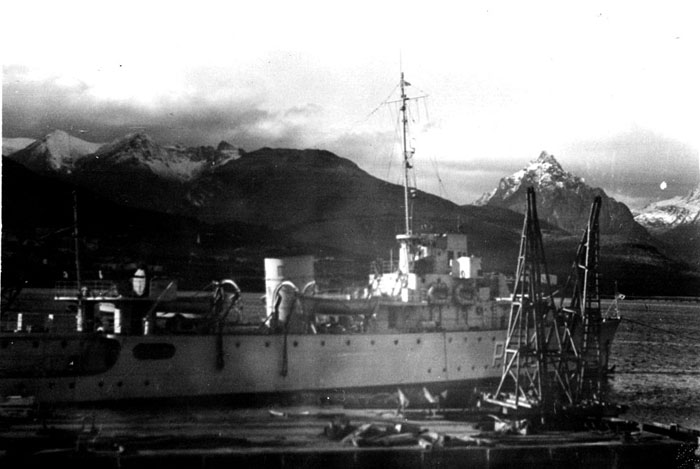
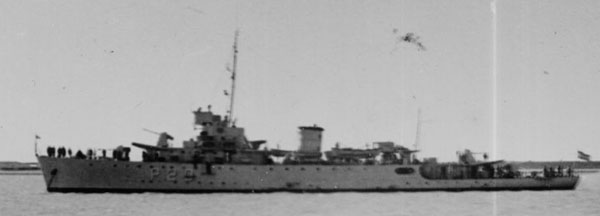
ARA King and Murature after WW2
Nevertheless, in late 1941 however, there were still some thought given to acquire US destroyers of the Gleaves class, but budget restrictions made it unlikely. In addition from December, it became impossible. Priorities, due to the developing battle of the Atlantic, which gradually shifted southwards in late 1942, motivating in 1943 the design of dedicated patrol vessels which became the Murature (king) class;
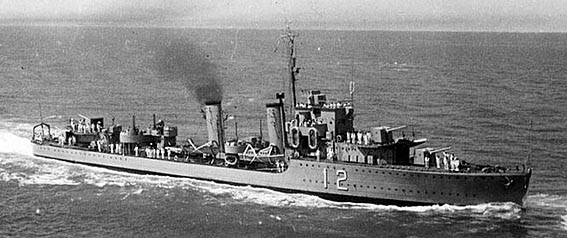
ARA Santa Cruz in February 1948
The interwar British-built destroyers were however gradually modernized and improved. After 1945 their AA was modernized twin 40 mm Bofors adopted, for the Churruca (later reclassed as torpedo boats), the Mendoza being modernized along the lines of the British Bruce class destroyers, (also reclasses as TBs in 1952), mostly AA.
The Buenos Aires received however the utmost attention, given radars, a modern Fire control system and single or twin 40mm/60 Mk 3 Bofors AA, and interestingly, two 24-tubes (178) Hedgehog ASWRL Mark 10, as well as later triple ASW 324mm TT launchers and K-Guns. They were discarded in 1971-1973 (renamed T-6 to T-12) by USN destroyers (see below).
It’s only in 1961 that the Armada would purchase new destroyers, to replace the 1930 Churucca at least: The D20 Brown, D21 spora, D2 Rosales were Fletcher class vessels in August 1961, still in “stock” conditions. However in 1971 were acquired in addition D23 Domeck Garcia, D24 Almirante Storni, fully upraded Fletchers. In 1972 the next interwar classes were replaced by the Segui class from 1972, far more potent Allen M. Sumner FRAM II vessels named Segui, Bouchard, Piedra Buena and Espra. At the same time, Argentina made its revolution by acquiring its first missile destroyers, the British-built Hercules class (missile) Type 42 destroyers.
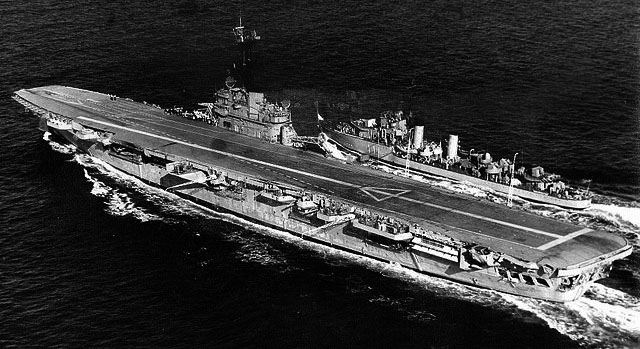
ARA Misiones (T11) escorting ARA Independencia in the 1960s
Read More:
Books
Chesneau, Roger, ed. (1980). Conway’s All the World’s Fighting Ships 1922–1946.
M.J. Whitley, Cruisers of World War Two, 1995, Arms and Armour Press
Blackman, Raymond V. B., ed. (1953). Jane’s Fighting Ships 1953–54. Low and Marston
Gardiner, Robert; Chumbley, Stephen & Budzbon, Przemysław, eds. (1995). Conway’s 1947–1995.
Whitley, M. J. (2000) Destroyers of World War Two: An International Encyclopedia.
Guillermo J. Montehengo, An Argentinian Naval Buildup in the Disarmament Era (Warship 2002-2003)
Links
On navypedia.org
On wrecksite.eu
ARA_Juan_de_Garay wiki es
On histarmar.com.ar: Full Service records.
Corrientes on www.histarmar.com.ar
Bomnbardment of Puerto Mar del Plata (ES)
Model kits
HMS Glowworm for the Buenos Aires class (G class) is a good base for work. The 1916 Scott or 1918 W class could also be used for easy transformation for the earlier ships.


 Latest Facebook Entry -
Latest Facebook Entry -  X(Tweeter) Naval Encyclopedia's deck archive
X(Tweeter) Naval Encyclopedia's deck archive Instagram (@navalencyc)
Instagram (@navalencyc)





 French Navy
French Navy Royal Navy
Royal Navy Russian Navy
Russian Navy Armada Espanola
Armada Espanola Austrian Navy
Austrian Navy K.u.K. Kriegsmarine
K.u.K. Kriegsmarine Dansk Marine
Dansk Marine Nautiko Hellenon
Nautiko Hellenon Koninklije Marine 1870
Koninklije Marine 1870 Marinha do Brasil
Marinha do Brasil Osmanlı Donanması
Osmanlı Donanması Marina Do Peru
Marina Do Peru Marinha do Portugal
Marinha do Portugal Regia Marina 1870
Regia Marina 1870 Nihhon Kaigun 1870
Nihhon Kaigun 1870 Preußische Marine 1870
Preußische Marine 1870 Russkiy Flot 1870
Russkiy Flot 1870 Svenska marinen
Svenska marinen Søværnet
Søværnet Union Navy
Union Navy Confederate Navy
Confederate Navy Armada de Argentina
Armada de Argentina Imperial Chinese Navy
Imperial Chinese Navy Marinha do Portugal
Marinha do Portugal Mexico
Mexico Kaiserliche Marine
Kaiserliche Marine 1898 US Navy
1898 US Navy Sovietskiy Flot
Sovietskiy Flot Royal Canadian Navy
Royal Canadian Navy Royal Australian Navy
Royal Australian Navy RNZN Fleet
RNZN Fleet Chinese Navy 1937
Chinese Navy 1937 Kriegsmarine
Kriegsmarine Chilean Navy
Chilean Navy Danish Navy
Danish Navy Finnish Navy
Finnish Navy Hellenic Navy
Hellenic Navy Polish Navy
Polish Navy Romanian Navy
Romanian Navy Turkish Navy
Turkish Navy Royal Yugoslav Navy
Royal Yugoslav Navy Royal Thai Navy
Royal Thai Navy Minor Navies
Minor Navies Albania
Albania Austria
Austria Belgium
Belgium Columbia
Columbia Costa Rica
Costa Rica Cuba
Cuba Czechoslovakia
Czechoslovakia Dominican Republic
Dominican Republic Haiti
Haiti Hungary
Hungary Honduras
Honduras Estonia
Estonia Iceland
Iceland Eire
Eire Equador
Equador Iran
Iran Iraq
Iraq Latvia
Latvia Liberia
Liberia Lithuania
Lithuania Mandchukuo
Mandchukuo Morocco
Morocco Nicaragua
Nicaragua Persia
Persia San Salvador
San Salvador Sarawak
Sarawak Uruguay
Uruguay Venezuela
Venezuela Zanzibar
Zanzibar Warsaw Pact Navies
Warsaw Pact Navies Bulgaria
Bulgaria Hungary
Hungary

 Bundesmarine
Bundesmarine Dutch Navy
Dutch Navy Hellenic Navy
Hellenic Navy Marina Militare
Marina Militare Yugoslav Navy
Yugoslav Navy Chinese Navy
Chinese Navy Indian Navy
Indian Navy Indonesian Navy
Indonesian Navy JMSDF
JMSDF North Korean Navy
North Korean Navy Pakistani Navy
Pakistani Navy Philippines Navy
Philippines Navy ROKN
ROKN Rep. of Singapore Navy
Rep. of Singapore Navy Taiwanese Navy
Taiwanese Navy IDF Navy
IDF Navy Saudi Navy
Saudi Navy Royal New Zealand Navy
Royal New Zealand Navy Egyptian Navy
Egyptian Navy South African Navy
South African Navy






























 Ukrainian Navy
Ukrainian Navy dbodesign
dbodesign